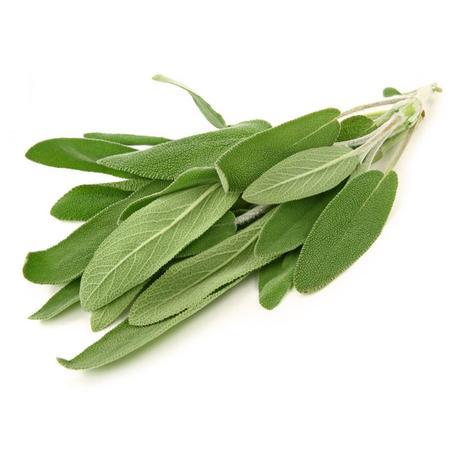Guest Editor: Christina Joell
copyright 22017 Art of Living, Prima Media, Inc

Sweet and savory – a flavor combination that is sought after by lots of people by lots of different food combinations. Luckily, you can get this alone from the wonderfully delicious herb: sage. It’s innate to the Mediterranean , though it can be grown in many different regions. It grows to 1-2 feet. The plant itself is beautiful, filled with woody stems and grayish-green leaves. The most attractive part of the plant is the blue/purple flowers that grow on it, which make it a nice decorative plant for people’s gardens. Like many other herbs, sage is a part of the mint family Lamiaceae, which means it has many useful properties to it. Alongside being decorative, it has culinary and medicinal uses. In fact, the meaning behind the name is “to be saved.” It can be served three different ways: fresh, ground and rubbed.
There are so many recipes that sage can be used in, from simply adding flavor to vegetables to stews. It is also very popular ingredient for turkey stuffing during Thanksgiving! You might think this herb is nothing more than a flavor enhancer for food. But this herb is another medical wonder kid.. It is an antiseptic and anti-inflammatory. It can be used for muscle aches, rheumatism and aromatherapy. Some of the oils in the plant have been able to enhance mental focus and improve memory, which has been really helpful in patients who have Alzheimer’s disease or simply those who are struggling cognitively with their memories
. Sage can be both culinary and medicinal when used as a tea. It is often referred to as the “thinker’s tea.” Fitting for an herb that helps your cognitive ability, right? The tea has even been able to help ease depression and aid in treating sore throats and coughs. Sage is rich in nutrition, containing vitamins and antioxidants. It contains fiber, calcium, iron, magnesium, vitamin A, vitamin C, vitamin E, and so much more. In fact, it is said that a single tablespoon of sage contains 43% of the daily recommended servings of vitamin K! It helps your internal body, but what about your external self? It is perfect for hair, skin and nails! It can help add shine and improve the texture of your hair as well as help to regulate oily skin.
During the period of ancient Rome, sage was considered to have substantial healing properties (especially with digestion – which is true!). The most known belief behind sage is that it was used to ward off evil spirits. Have you ever seen a scary movie where they start burning what looks like incense and waving it around the house? This isn’t Hollywood magic or made up. It’s because white sage is supposed to ward off evil spirit, repel enemies and get rid of negative energy in an attempt of purification. So, in horror movies, they attempt to “get rid of the ghost” by burning sage and waving it around the house. It was also believed that Sage was the key to a long life.
There is an annual sage festival that takes place in Windsor, North Carolina. The admission is free and there is music, vendors, art, crafts and much more. There is also a yearly Virginia Herb Festival that features sage and many other amazing herbs for a small fee of $5 for admission.
et and savory – a flavor combination that is sought after by lots of people by lots of different food combinations. Luckily, you can get this alone from the wonderfully delicious herb: sage. It’s innate to the Mediterranean , though it can be grown in many different regions. It grows to 1-2 feet. The plant itself is beautiful, filled with woody stems and grayish-green leaves. The most attractive part of the plant is the blue/purple flowers that grow on it, which make it a nice decorative plant for people’s gardens. Like many other herbs, sage is a part of the mint family Lamiaceae, which means it has many useful properties to it. Alongside being decorative, it has culinary and medicinal uses. In fact, the meaning behind the name is “to be saved.” It can be served three different ways: fresh, ground and rubbed.
There are so many recipes that sage can be used in, from simply adding flavor to vegetables to stews. It is also very popular ingredient for turkey stuffing during Thanksgiving! You might think this herb is nothing more than a flavor enhancer for food. But this herb is another medical wonder kid.. It is an antiseptic and anti-inflammatory. It can be used for muscle aches, rheumatism and aromatherapy. Some of the oils in the plant have been able to enhance mental focus and improve memory, which has been really helpful in patients who have Alzheimer’s disease or simply those who are struggling cognitively with their memories
. Sage can be both culinary and medicinal when used as a tea. It is often referred to as the “thinker’s tea.” Fitting for an herb that helps your cognitive ability, right? The tea has even been able to help ease depression and aid in treating sore throats and coughs. Sage is rich in nutrition, containing vitamins and antioxidants. It contains fiber, calcium, iron, magnesium, vitamin A, vitamin C, vitamin E, and so much more. In fact, it is said that a single tablespoon of sage contains 43% of the daily recommended servings of vitamin K! It helps your internal body, but what about your external self? It is perfect for hair, skin and nails! It can help add shine and improve the texture of your hair as well as help to regulate oily skin.
During the period of ancient Rome, sage was considered to have substantial healing properties (especially with digestion – which is true!). The most known belief behind sage is that it was used to ward off evil spirits. Have you ever seen a scary movie where they start burning what looks like incense and waving it around the house? This isn’t Hollywood magic or made up. It’s because white sage is supposed to ward off evil spirit, repel enemies and get rid of negative energy in an attempt of purification. So, in horror movies, they attempt to “get rid of the ghost” by burning sage and waving it around the house. It was also believed that Sage was the key to a long life.
There is an annual sage festival that takes place in Windsor, North Carolina. The admission is free and there is music, vendors, art, crafts and much more. There is also a yearly Virginia Herb Festival that features sage and many other amazing herbs for a small fee of $5 for admission
For more great recipes get your copy of the Gourmand World Award Winning book The Basic Art of Italian Cooking: Holidays and Special Occasions-2nd edition

